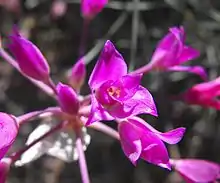Allium peninsulare
Allium peninsulare is a North American species of wild onion.[1] It is known by such common names as Mexicali onion and Peninsula onion; the former referring to the Mexican city just south of the US/Mexican border, the latter referring to the Peninsula of Baja California. It is widespread in California, USA, where it grows in the California Coast Ranges, Sierra Nevada foothills, some of the Channel Islands, and Peninsular Ranges. The range extends south into the northernmost part of Baja California and north into southern Oregon.[3][4]
| Allium peninsulare | |
|---|---|
 | |
| Allium peninsulare | |
| Scientific classification | |
| Kingdom: | Plantae |
| Clade: | Tracheophytes |
| Clade: | Angiosperms |
| Clade: | Monocots |
| Order: | Asparagales |
| Family: | Amaryllidaceae |
| Subfamily: | Allioideae |
| Genus: | Allium |
| Species: | A. peninsulare |
| Binomial name | |
| Allium peninsulare | |
Description
Allium peninsulare is usually found in Valley Grassland, Foothill Woodland, and Coastal Chaparral at elevations up to 1100 m (3660 feet). The plant produces a bulb 8–15 mm wide and has two to three channeled to more or less cylindrical leaves. Between May and July, it sends up a 12–45 cm scape topped with an umbel of 5–35 flowers, each on an 0.8–4 cm pedicel. The flowers are red-purple and have six triangular tepals. The three inner tepals are smaller than the outer ones and have teeth along the margins.[3][5][2]
- A. peninsulare var. franciscanum McNeal & Ownbey[6] --- leaves arched; stigma, unlobed or obscurely 3- lobed --- central California from Mendocino County to Monterey County
- A. peninsulare var. peninsulare — leaves straight, stigma strongly 3- lobed --- widespread from Baja California to Oregon
- formerly included[1]
Allium peninsulare var. crispum (Greene) Jeps., now called Allium crispum Greene
References
- "Allium peninsulare", World Checklist of Selected Plant Families, Royal Botanic Gardens, Kew, retrieved 2015-04-16
- Greene, Edward Lee. 1888. Pittonia 1(11): 165.
- Flora of North America, v 26 p 265, Allium peninsulare
- Calflora Taxon Report 223, Allium peninsulare
- Jepson Manual Treatment - Allium peninsulare
- McNeal, Dale W. 1992. New taxa and combinations in North American Liliaceae. Phytologia 73(4): 307–311.
| Wikimedia Commons has media related to Allium peninsulare. |
| Wikispecies has information related to Allium peninsulare. |